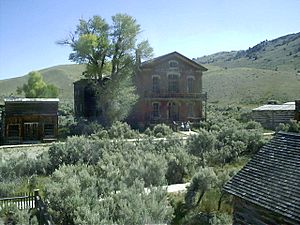List of ghost towns in Montana facts for kids
Imagine a town where everyone has left, and buildings stand empty, like a forgotten memory. These are called ghost towns. Montana, a state known for its rich history of mining and pioneers, has many of these silent places. A ghost town is a place that used to be a busy town or city but has now lost most or all of its people and businesses.
Contents
What is a Ghost Town?
A ghost town is a community that has become mostly or completely empty. This happens when the main reason people lived there disappears. Think of it like a toy that no one plays with anymore. It just sits there, slowly getting dusty.
Why Do Towns Become Ghost Towns?
Towns often become ghost towns for several reasons. Most of the time, it's because the economic activity that supported them has stopped.
Mining Towns
Many Montana ghost towns were once busy mining camps. People rushed to these places hoping to find gold, silver, or other valuable minerals. When the mines ran out of ore, or the price of minerals dropped, people moved away to find work elsewhere. The buildings were left behind, slowly decaying.
Changes in Transportation
Sometimes, a town might lose its importance because new roads or railroads are built somewhere else. If a town was a stop along an old trail or a river, and then a new, faster route opened up, people and businesses would move to the new route. The old town would slowly fade away.
Natural Disasters or Other Events
Less often, a town might become a ghost town due to a natural disaster like a flood or a big fire. Government actions, like building a dam that floods a town, can also create a ghost town. Even things like lawlessness in the early days could make people leave a dangerous place.
Famous Montana Ghost Towns
Montana has many interesting ghost towns, each with its own story. Some are completely abandoned, while others still have a few people living there, keeping the history alive.
Bannack
Bannack is one of Montana's most famous ghost towns. It was the first territorial capital of Montana in 1864. Bannack was founded in 1862 after gold was discovered nearby. At its peak, it had over 10,000 residents! Today, Bannack is a state park, and many of its original buildings are still standing. You can visit and imagine what life was like during the gold rush. It's located in Beaverhead County.
Elkhorn
Elkhorn is another well-preserved ghost town. It was a silver mining town that boomed in the 1880s. The town had a school, a church, and many homes. When the silver mines closed, most people left. Today, some buildings, like the Fraternal Hall and the schoolhouse, are still standing. A few people still live in Elkhorn, keeping it from being completely abandoned. It's in Jefferson County.
Garnet
Garnet is Montana's most intact ghost town. It was a gold mining town that started in the 1860s. It had a population of about 1,000 people at its peak. When the gold ran out, the town slowly emptied. The buildings are now protected, and visitors can explore the old saloon, hotel, and cabins. Garnet is located in Granite County.
Towns with Remaining Residents
Some towns that were once bustling mining or agricultural centers now have only a few people left. These places are often called "near ghost towns" because they still have a small population, but they are much quieter than they used to be. Examples include:
- Albion in Carter County
- Bear Creek in Carbon County
- Carlyle in Wibaux County
- Comertown in Sheridan County
- Ingomar in Rosebud County
- Marysville in Lewis and Clark County
- Nevada City in Madison County
- Virginia City in Madison County
These towns are like living museums, showing us how Montana grew and changed over time. They remind us of the exciting history of the American West.
See also
- History of Montana
- List of cities and towns in Montana
- List of counties in Montana
- List of places in Montana
- Outline of Montana


